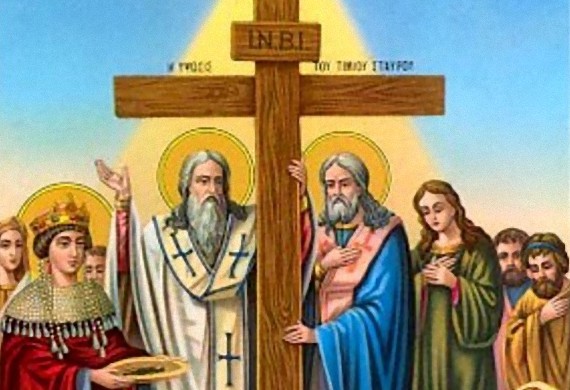The Elevation of the Cross is celebrated on September 14th. During this feast we commemorate the finding of the Cross of Christ by Saint Helen, mother of Constantine the Great, in the 4th AD century; we also celebrate the recovery of the Cross by the emperor Heraclitus, after its capture by the Persians, in the 7th century, and its Elevation in the Temple of the Resurrection in Jerusalem. From this last event, the “Universal Elevation” of the Cross was annually celebrated in all the churches of the Byzantine Empire.
The day of the Elevation of the Holy Cross was a national holiday of the Byzantine Empire. The Cross, which was the official emblem of the Empire and was found on all public buildings and official uniforms, was solemnly raised on that day by the bishops and priests. They blessed the four points of the horizon with the Cross, while the faithful chanted “Lord have mercy”. This rite is still performed today in the churches after the official procession and the raising of the cross at the end of the Service for those Fallen Asleep “Panikhida” and before the Great Doxology of Orthros (Matins).
The Troparion of the holiday which was, one might say, the “national anthem” of the Byzantine Empire, was originally a plea to God to save the people, grant victory in the war and preserve the empire by the grace of the Cross. Today the Troparion and all the hymns of the day, which speak of “barbarians”, refer to the spiritually wicked and sinners, as well as the devil and his armies, while the Orthodox Christians substitute, allegorically, the “kings”.
Troparion of the Elevation of the Holy Cross, Tone 1
O Lord, save Thy people and bless Thine inheritance. Grant victory over their enemies to Orthodox Christians, and protect Thy people with Thy Cross.
Kontakion of the Elevation of the Holy Cross, Tone 4
O Christ our God, Who wast voluntarily lifted up on the Cross, grant Thy mercies to Thy new people named after Thee. Gladden with Thy power Orthodox Christians and give them victory over their enemies. May they have as ally that invincible trophy, Thy weapon of peace.
The day of the Elevation of the Cross, although it is obvious that has a “political” origin, it occupies a place of great importance in the Church today. It still exists as a day of fasting and prayer, a day in which we remember that the Cross is the only worthy symbol of our faith and that our salvation does not come from some earthly victories, but only from the real and lasting victory of the Crucifixion of Christ and of our own inter-crucifixion with Him.
When we raise the Cross and kneel before it in reverence and worship to God, we declare that we do not belong to the Kingdom of this world, and that real and lasting citizenship is that which we acquire together with the saints, in the “city of God” (Eph. 2,19; Heb. 11,10; Rev. 21-22).
The first of the Old Testament readings at Vespers speaks of the “tree” that turns the bitter waters into sweetness – the symbolism of the Tree of the Cross (Exod. 15.22 – 16.1). The second reading reminds us that the Lord punishes and controls those he loves, and that the Divine Wisdom “is a tree of life to all who endure it, and to those who trust in it as in the Lord” (Prov. 3:11-18). Again, reference is made to the Cross which is, as the apostolic reading of the day proclaims, “to those who are saved… the power of God and the wisdom of God” (1 Cor. 1:18-25).
The third reading from the Old Testament is from the Prophecy of Isaiah which speaks of the “city of the Lord”, where the Jews together with the Gentiles will live together and bow down at the feet of the Lord “and know that I am the Lord who saves you and excepted to the God of Israel” (Is. 60:11-16). Here we have a direct reference to the city of God, where people will worship Him at His feet; and the verse of the Psalm is repeated that calls us “worship the footstool of His feet”, which again refers to the Holy Cross (Ps. 98,5).
“We worship your Cross, Despot, and we glorify your holy Resurrection.”
This Elevation hymn, sung in the Church for eight days, is sung many times. It replaces the Trisagion Hymn in the Divine Liturgy. And the antiphons that are sung normally are replaced by verses of the psalms, which have a direct reference to the Crucifixion of Christ (Ps. 22, 74, 99). In Orthros (Matins), in the Gospel reading from the Gospel of John, Christ says that when he ascends the Cross, he will draw all people to him (John 12, 28-36). The great Gospel passage of the Divine Liturgy is the description of the Lord’s Passion from the Gospel according to John.
Thus, during the feast of the Elevation of the Holy and Life-giving Cross, Christians rededicate their lives to the Crucified Lord and give their undivided faith to Him, with the worship of the Cross, to which His holy body parts were nailed. This is for the Church the meaning of this holy day, which is a day of fasting and repentance.
Translated for Enomeni Romiosini
Greek source:
Elevation of the Holy and Life-Giving Cross

